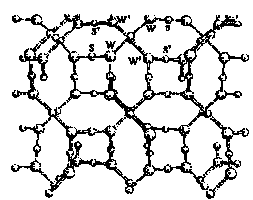
TEMPLATE NETWORK AND SITE SYSTEMATICS OF EXTRAFRAMEWORK ATOMS IN THE ANALCIME-LEUCITE STRUCTURE TYPE Bakakin V.V.*, Seryotkin Yu.V., Fursenko B.A., Belitsky I.A. Institute of Mineralogy and Petrography, Novosibirsk, 630090, Russia *Institute of Inorganic Chemistry, Novosibirsk, 630090, Russia.
The analcime-leucite structure family (ANA-type) comprises more than 70 natural and synthetic compounds. The (pseudo)cubic cell parameters lie in the range from 12.6 to 14 Å 12 space groups are known. The general formula for the group can be expressed as: (L16)W16S24[T48O96], where [T48O96] - tetrahedral framework of the ANA-topology, L (from Lithium) - positions with coordinations (by anions): 3l, 3n, 4t, 6o; S (from Sodium) - 4s, 6o, 5y, 4t2c, 8do, 6p, 4t; W (from Water) - 6o6c, 6o3c, 6p3c. More than 20 various combinations of L-, S-, W-site occupations existing in real compounds (both natural and modified) are presented. A comparative analysis of 30 ANA-type compounds for which the full crystal structure data are available demonstrates existing variations in composition and/or symmetry in the family. The correlations were found between cell volume, (T-O) avr, <(T-O-T)avr, and ionic radii RS and RW.
ANA-framework structure genesis is discussed in terms of template approach. An important feature not noted before is that a large-volume W (or W+S) components form two enantiomorphous interpenetrating 3-dimensional 3-connected 10-gon nets (of a (10,3)-a type after A.F.Wells) acting as a template. For NW/NT = 1/3 it is this network which provides uniform interaction between template W (or W+S) components and TO4/2 framework constituents. Conventionally one can to subdivide the whole tetrahedral framework into two subsystems as if generated by different W,S subnets.
